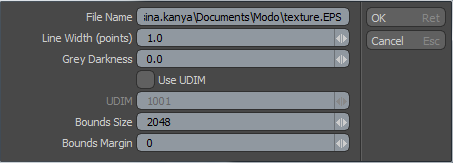Export UVs to EPS
With the Export UVs to EPS command, you can export a UV map to an external application for additional processing in the resolution-independent .eps vector format. The .eps file is useful as a reference point when you open it in an image-editing application (such as Photoshop) to create bitmap textures.
To use this command, follow these steps:
| 1. | Select the target UV map in the Lists > UV Maps tab. |
| 2. | In the menu bar, click Texture > Export UVs to EPS. |
An OS-specific file browser opens.
| 3. | Specify a file name and the location for saving the file. |
The Export UVs to EPS dialog opens.

|
Export UVs to EPS |
|
|
File Name |
The path and name of the EPS file. |
|
Line Width (points) |
The Postscript line width for drawing polygon edges. Measured in points. |
|
Grey Darkness |
The Postscript gray level for drawing polygon edges. 0 is white, 1 is black. |
|
Use UDIM |
Check this to only export UVs in a specific UV tile. |
|
UDIM |
If you have checked Use UDIM, choose a UDIM location for the UV source. |
|
Bounds Size |
The size of the square EPS bounding box. Measured in points. |
|
Bounds Margin |
The size of the horizontal and vertical margins for the square EPS bounding box. Measured in points. |
| 4. | Edit the settings you need, then click OK. |
Modo exports your UV map to .eps format.
